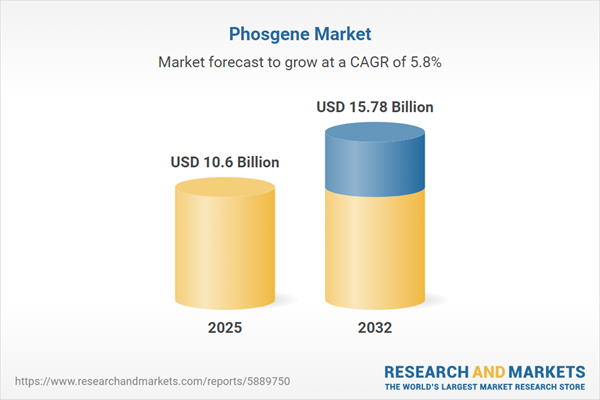Speak directly to the analyst to clarify any post sales queries you may have.
As industries face mounting safety and regulatory demands, the phosgene market continues to serve as a linchpin for manufacturing critical derivatives used across sectors, sparking strategic shifts among global decision-makers.
Phosgene Market Snapshot
The phosgene market is experiencing steady growth, moving from USD 10.04 billion in 2024 to USD 10.60 billion in 2025, with a projected CAGR of 5.80% through 2032, ultimately reaching USD 15.78 billion. This momentum is underpinned by robust demand for derivatives in polymer, agrochemical, and pharmaceutical production, and further shaped by evolving safety, regulatory, and trade frameworks in major economies. Strategic pivots in sourcing and production technologies are enabling market participants to address risk, cost, and efficiency across the supply chain.
Scope & Comprehensive Segmentation
This report delivers a detailed analysis of the phosgene market, emphasizing operational, regional, and application dimensions. Segmentation features:
- Derivative Types: Acid chlorides, carbamates, chloroformates, isocyanates—all essential to end uses such as polymers, specialty chemicals, and agrochemical synthesis.
- Product Forms: Gaseous and liquid phosgene, with each form driving unique plant design and safety requirements.
- Applications: Agrochemical production, dyes and pigments, fine chemicals, pharmaceutical intermediates, and polycarbonate manufacturing, capturing the diversity of demand.
- Distribution Channels: Offline bulk purchasing as well as online procurement platforms for rapid fulfillment and improved transparency.
- Geographic Coverage: Americas (including United States, Canada, Mexico, Brazil, Argentina, Chile, Colombia, Peru), Europe (United Kingdom, Germany, France, Russia, Italy, Spain, Netherlands, Sweden, Poland, Switzerland), Middle East (United Arab Emirates, Saudi Arabia, Qatar, Turkey, Israel), Africa (South Africa, Nigeria, Egypt, Kenya), Asia-Pacific (China, India, Japan, Australia, South Korea, Indonesia, Thailand, Malaysia, Singapore, Taiwan).
- Key Companies Examined: ALTIVIA Chemicals, Anhui Guangxin Agrochemical, Arkema, Atul Ltd., BASF, BUSS ChemTech, Chemical Design, Chuo Kaseihin, Covestro, Drägerwerk, Hodogaya Chemical, Lanxess, Merck, Paushak, PMC ISOCHEM, Shandong Tianan Chemicals, Shreno Engineering, Synthesia, UPL Limited, VanDeMark Chemical, Wanhua Chemical Group.
Key Takeaways for Senior Decision-Makers
- Phosgene’s strategic value is anchored in its role as a precursor to high-value derivatives for polymers, agrochemicals, and pharmaceuticals.
- Process innovation—such as the adoption of microreactor and membrane technologies—is streamlining production while supporting safer containment and compliance.
- Rising regulatory expectations necessitate significant investment in advanced safety systems, closed-loop handling, and comprehensive workforce training to protect both employees and local communities.
- Segment-specific applications create complex supply chain and product development challenges, with tailored R&D strategies favoring those who closely align with end-user requirements.
- The competitive landscape favors players that integrate value chain operations and build strategic alliances, accelerating new product launches and improving market responsiveness.
- Digitalization, including the use of digital twins, is enabling proactive risk management and operational optimization throughout the lifecycle of phosgene production and downstream processing.
Tariff Impact: U.S. Policy and Global Recalibration
The 2025 revision of United States tariffs on phosgene and intermediates has altered the cost structure for importers, driving a shift toward domestic sourcing and rebalanced trade flows. This adjustment is prompting production realignment in North America and fueling growth in Asia-Pacific and European markets. Logistics operations are adapting to new congestion patterns and inventory optimization challenges as firms respond to increased volatility and refined sourcing strategies.
Methodology & Data Sources
This report is grounded in a structured multi-phase approach, including a review of peer-reviewed literature, patent filings, and regulatory guidelines. Direct interviews with industry executives and engineers complement secondary research from trade databases and financial disclosures. Quantitative modeling and scenario analysis are employed, with findings validated through triangulation from multiple expert and data sources to ensure reliable and actionable intelligence.
Why This Report Matters
- Supports informed capital allocation and risk mitigation strategies amidst changing market and regulatory environments.
- Delivers actionable segmentation and supply chain insights tailored to industry-specific adoption, technology trends, and end-user requirements.
- Facilitates benchmarking of competitive positioning and identification of regional growth opportunities based on local infrastructure and compliance dynamics.
Conclusion
This phosgene market analysis enables executive leaders to act decisively, balancing the demands of regulation, technology adoption, and shifting trade patterns. The intelligence provided supports robust decision-making for long-term competitiveness and resilience.
Additional Product Information:
- Purchase of this report includes 1 year online access with quarterly updates.
- This report can be updated on request. Please contact our Customer Experience team using the Ask a Question widget on our website.
Table of Contents
3. Executive Summary
4. Market Overview
7. Cumulative Impact of Artificial Intelligence 2025
Companies Mentioned
The companies profiled in this Phosgene market report include:- ALTIVIA Chemicals, LLC
- Anhui Guangxin Agrochemical Co., Ltd.
- Arkema S.A.
- Atul Ltd.
- BASF SE
- BUSS ChemTech AG
- Chemical Design, Inc.
- Chuo Kaseihin Co., Inc.
- Covestro AG
- Drägerwerk AG & Co. KGaA,
- Hodogaya Chemical Group
- Lanxess AG
- Merck KGaA
- Paushak Ltd.
- PMC ISOCHEM
- Shandong Tianan Chemicals Co., Ltd
- Shreno Engineering Limited
- Synthesia, a.s.
- UPL Limited
- VanDeMark Chemical Inc.
- Wanhua Chemical Group Co.,Ltd.
Table Information
| Report Attribute | Details |
|---|---|
| No. of Pages | 194 |
| Published | November 2025 |
| Forecast Period | 2025 - 2032 |
| Estimated Market Value ( USD | $ 10.6 Billion |
| Forecasted Market Value ( USD | $ 15.78 Billion |
| Compound Annual Growth Rate | 5.8% |
| Regions Covered | Global |
| No. of Companies Mentioned | 22 |









